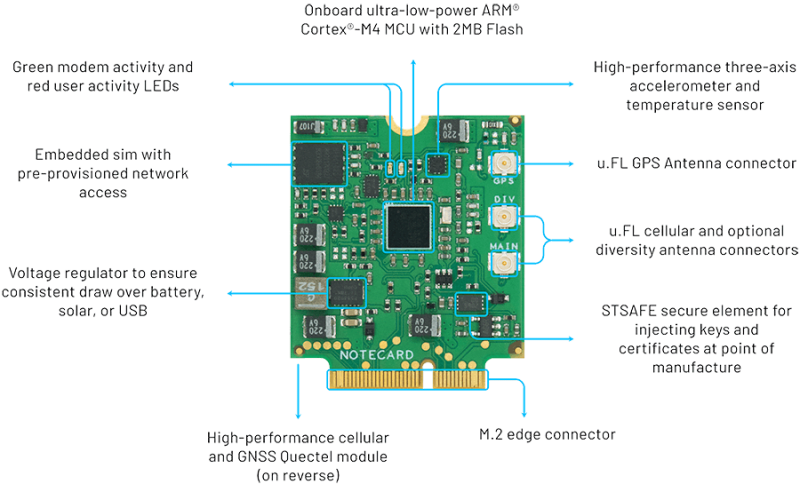Title image credit @jxk on Unsplash.
If you've been following along in our blog series, you have learned what cellular IoT really is and read about some advantages for using cellular in your IoT projects.
But what are some tangible examples of those solutions? Who is using cellular in production IoT projects today? There are many valid (and obvious) use cases for cellular IoT, and yet there are additional scenarios where cellular isn't normally considered, but should be.
In this blog series we are demystifying cellular and taking a critical look at four key topics related to wireless connectivity in the Internet of Things:
- What is Cellular IoT?
- The Advantages of Cellular IoT
- Common Use Cases for Cellular IoT (that's today)
- Cellular IoT Network and Infrastructure Redundancy
Monitoring of Critical Systems
Imagine power is lost, either maliciously or due to a local outage. Is your (now battery-powered) solution monitoring a critical system that needs to maintain active reporting of data? Maybe you are monitoring:
- Physical security (e.g. intrusion detection)
- Presence of smoke, fire, or water
- HVAC system function
These implementations generally require 24/7/365 uptime, and so does your network access. Therefore, relying on a network outside of your internal infrastructure should be a key requirement.
Global, Remote, and Outdoor Deployments
Cellular networks are ubiquitous to the extent that they are the only networking option that can be considered truly "global". Whether you are tracking assets from country to country, deploying solutions that are stationary but in unpredictable locations, or installing outside the range of Wi-Fi, cellular is the only viable option.
IoT solutions deployed in rural or agricultural settings that only have 2G access often rely on cellular for connectivity.
Smart Cities
While some cities have tried to set up their own public Wi-Fi networks (with varying degrees of success), most rely upon cellular for their "smart city" initiatives.
A great example of this is utility meters. Normally installed inside or attached to the outside of a home or office; gas, electrical, and water meter values need to be measured on a regular basis in order to provide the accurate billing statements. Cellular provides the best choice for municipalities who want to both automate the collection of this data and provide real time access, from city center to the distant suburbs.
"It Just Works" Deployment
When's the last time you bought a device and then had to figure out how to connect it to your home Wi-Fi network? Now imagine yourself a non-technical user who doesn't know the SSID or even the password for your Wi-Fi router.
Cellular allows for pre-provisioned network access that "just works" when the end user turns on the device. Numerous consumer-installed IoT devices like smoke, fire, radon, and carbon monoxide can take advantage of providing a friction-free end user installation experience.
Cellular as a Fallback
Everything we have referenced so far is not making a case against other connectivity options. In fact, there are numerous scenarios where Wi-Fi or LoRa make more sense than cellular. This brings up another valid use case for cellular though: as a fallback solution.
What happens if your local network gateway is disabled due to either a power failure or hardware issue? If a Wi-Fi router decides to stop working in the middle of the night, can your deployment gracefully recover? Cellular can be enabled as a failsafe network backup to ensure no lapses in connectivity.
The Notecard for All of the Above
The Notecard from Blues Wireless provides wireless cellular connectivity for IoT projects of all types. It checks all the boxes we've mentioned, and then some.
The Notecard is a secure device-to-cloud data-pump that comes with 500 MB of data and 10 years of cellular service. The SoM itself measures 30mm x 34mm SoM and ships ready to embed in a project via its M.2 edge connector. To make prototyping IoT projects easier, Blues Wireless provides a series of expansion boards to host the Notecard called Notecarriers.
Summary
Cellular IoT is often the best choice for a wide range of IoT applications, especially those in varied and unpredictable settings. From smart cities with their remotely-monitored lights and parking meters, to critical system monitoring, even to self-driving cars and beyond, the reliability, security, and ubiquity of cellular connections make it the most logical choice for IoT solutions of all types
Learn more about how Blues Wireless is making cellular IoT adoption easier for businesses AND developers with the Notecard and Notecarrier (and check out the next post in this series on Cellular IoT Network and Infrastructure Redundancy).









Top comments (0)